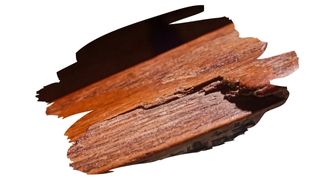Are you starting to see fine splits and barely-there cracks appear on the surface of your wood carvings? Wondering if there’s something you can do to prevent that crack from turning into an eye-sore of a split?
Well, wood cracking is a very common problem that happens whenever you work with wood that hasn’t been seasoned.
Often referred to as ‘green’ wood, this wood has a high moisture content. And that excess moisture can make timber much more susceptible to splitting and checking as it dries out and shrinks.
But can a few coats of Tung oil be enough to prevent this from happening to your craft?
Well, in this post, you will find out why wood can start to crack — and why a simple drying process called ‘seasoning’ is key to helping prevent those fractures.
You’ll also discover the two best ways to stop wood from splitting apart. And keep reading to find out if a Tung oil finish alone can really fend off those wood cracks.

This post may contain affiliate links to products that we receive a commission for (at no additional cost to you). Learn more here.
Why Does Wood Crack Apart As It Dries?
It all comes down to water.
Freshly logged timber has a lot of water saturating its wood fibers. This is usually referred to as the ‘moisture content’ of a piece of wood. And newly logged lumber has a moisture content of almost 100%.
But all of that extra water sloshing around can make wood unstable. Particularly once it begins to evaporate.
So, before we can start to work with any piece of timber, we need to let it dry — A.K.A ‘seasoning’.
Now, seasoning can take up to 6-12 months to complete. After that, woods moisture content will usually drop to under 19%.
But, as water evaporates, it can cause wood to shrink. And this is still the case even if you start working on an unseasoned log or board.
What’s more, the quicker wood dries, the quicker it’ll shrinks. And if it shrinks far too fast, it will become brittle and start to crack — and this is referred to as wood ‘checking’.

OK…So How Do You Keep Wood Furniture From Cracking?
The only way to stop wood from cracking is to slow the process of evaporation down. And there are two general methods you can do to achieve this;
1). Regulate Humidity Levels
This essentially involves regulating the moisture in the environment around wood. As long as you keep humidity levels between 45% and 65%, moisture won’t escape from wood too quickly.
Now, the simplest way to reduce the humidity in a very dry area is by using a dehumidifier. And the easiest way to increase the humidity is by using a vaporizer or cool steam machine.
However, managing the humidity in any given space isn’t always the most practical option. So, more often than not, you are much better off simply…
2). Applying A Top Coating Sealant
This method involves coating wood with a water-resistant sealant that’ll stop water vapor from escaping (or getting into) wood.
Applying a quality sealant, (especially over the end grain of a log), will prevent wood from drying too quickly.
Related Post: What To Do When Solid Wood Cabinet Doors Start Warping (Solved!)
An end grain sealer, for example, is a fantastic way to prevent wood turning logs from cracking. By coating the exposed end grain, you can prevent a log from drying out unevenly.
However, you should use a waterproofing sealant specifically, typically a urethane-based sealant such as polyurethane. This is an especially important point if you happen to be based in a very hot locale.
You see, most widely used wood finishes, such as Linseed oil, are microporous wood finishes. Which means that they aren’t water-resistant enough to prevent vapor from escaping during the hottest months of the year.
Wait A Second…What Do You Mean By Microporous Wood Finish?
A microporous wood finish is a water-repellent, but not waterproof, wood finish.
These finishes can prevent liquid droplets from sinking past their film. However, they are not waterproof enough to stop water vapor (i.e. evaporating moisture) from getting past.
That’s why microporous finishes become damaged if you put a hot cup of coffee on top of them. The combined heat and condensation on that cup will sink past a microporous finish — into the wooden surface underneath.
What About Tung Oil? Is Tung Oil At Least Waterproof? Or Is It Microporous Too?
Tung oil is more of a water-repellent finish than a waterproof one. And that is because it too is a microporous finish.
So, while it can certainly slow down evaporation in general, it won’t be able to keep wood hydrated in very dry environments.
Now having said that, even in ideal conditions, Tung oil should be used only as a preventative measure against wood cracking. That’s because Tung oil isn’t going to be enough to stop an already present wood check from splitting even further.
Related Post: Is Tung Oil A Good Enough Finish For Outdoor Furniture?
To Wrap Up, Here Are The 3 Key Takeaways From This Post…
- 1). When wood starts to split and check, it is due to moisture evaporation. As water vapor escapes from wood, wood shrinks and contracts, causing it to crack as it does so.
- 2). The best way to stop cracking is to slow down the pace of evaporation. You can do this by simply managing the humidity levels around wood, or by coating any exposed wood grain with a waterproof sealant.
- 3). Tung oil is a water-repelling finish, but it is not a waterproofing sealant. This means that it can help to slow down evaporation. But, in hotter climates, Tung oil may do little to prevent water vapor from escaping.



